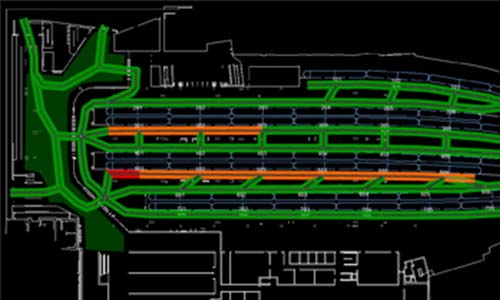Train stations are certainly some of the most bustling places on earth. Some of the largest stations worldwide serve millions of passengers every day. Even the medium size stations have to handle tens of thousands of people rushing to the platform or using the opportunities for retail and leisure. Have you ever wondered how these highly frequented transportation hubs manage these huge passenger flows? Station capacity planning and crowd simulation are keywords here.
Let’s jump into an example in the UK: Network Rail owns the over 2,500 train stations across the country and manages 20 of the largest and busiest themselves. To ensure the best experience for passengers, the company aims to create stations that are accessible to everyone and to ensure smooth, efficient, and safe operations, even during peak periods. Station planners have to answer questions like “How long does it take to transfer between services?” or “Are the connection times realistic?” To analyze detailed passenger movements within their stations, Network Rail recently adopted a new tool – a first-of-a-kind solution based on PTV technology.
A detailed but easy-to-use solution

When it comes to station capacity planning, microsimulation models are a kind of gold standard. Such models are very detailed and complex and hence require large amounts of data including passenger numbers, accurate station layouts, and calibrated parameters. Each individual scenario can be evaluated down to the minutest detail. They are mainly used to model large terminus stations, where there are complex interactions between passengers across multiple concourses, retail facilities, platforms, and exits. Smaller stations often rely on simple spreadsheet-based calculations without detailed representation of station layout and passenger conflicts.
“There is a large gap in detail and modeling effort between these two options. That’s why Network Rail have worked with us at PTV to develop a new, intermediate solution where a model can be developed, and scenarios evaluated more quickly than with microsimulation but with sufficient detail to analyze different station layouts and evaluate possible interventions to manage capacity”, says David Aspital of PTV.
The new solution for station capacity analysis allows for a station model to be built, run, and analyzed in a few hours. It was developed around PTV Visum, utilizing its data structures to store demand data such as matrices of passenger movements and run simulations before exporting a standard set of analyses such as passenger flows, platform densities and station clearance times.
This mesoscopic approach allows the modeling of individual passengers through a station layout, including the interaction of passengers on walkways, stairs, platforms, or concourses. Meanwhile, key metrics such as queue length, walking speeds, and levels of service can be analyzed throughout the station. The tool works with standard datasets, like timetables, passenger numbers and station layouts which are available for stations across the entire network.
“Models can be set up quickly which means that different scenarios and measures can be tested very quickly and on a consistent basis”, says David Aspital. “There are various possibilities of visualization, which is another advantage. ‘Moving-dot’ animations, for example, showing passengers moving through the station or graphs of passenger numbers, density, or delay. These are easy to understand and can be even shared with stakeholders who don’t have a technical background.”
Besides station capacity analysis, planners can use the new tool for various other use cases – to model the entire passenger experience for example, or to give insights in relation to safety.

Daniel Chaney, Senior Station Capacity Planner, Network Rail adds: “Having such a tool is a game-changer for our analysis, not only allowing us to undertake advanced assessments much more quickly but also in terms of transparency and governance, where the methodology is much more defined and controlled than previous spreadsheet modeling. The capability for Visum to interpret these models as a network or line system is a ‘first of a kind’ for the UK rail network and is an exciting opportunity to better serve our passengers, such as by minimizing crowding and simplifying interchanges.”
